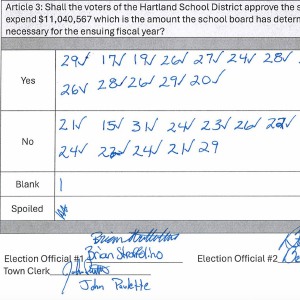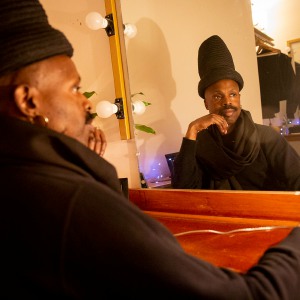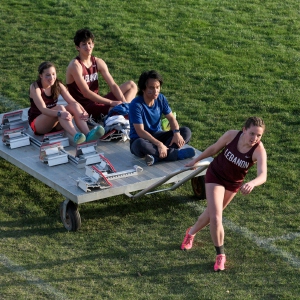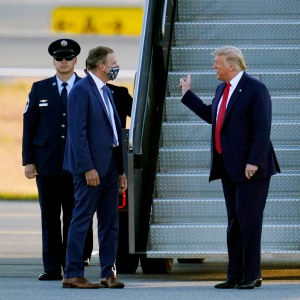Column: A tale of two governors in two states, one red and one blue
| Published: 02-06-2023 9:47 AM |
Last November, two governors, the Republican governor of Iowa and the Democratic governor of New Mexico, overwhelmingly won reelection. Each enjoys legislative majorities from her own party.
The way each governor has chosen to exercise her mandate tells us a great deal about red and blue America.
As someone who spent his high school years in Iowa and still follows the state’s political machinations, I had high hopes for Kim Reynolds, who became governor in 2017 after Donald Trump appointed Terry Branstad as ambassador to China. Reynolds is Iowa’s first female governor, and I thought she might model her administration on that of one of her Republican predecessors, Robert D. Ray, an irenic, gentle man who served as governor from 1969 to 1983 and always sought bipartisan consensus.
Reynolds, however, decided to go full Trump. She proposed slashing $10 million from Medicaid, signed one of the most restrictive anti-abortion bills in the country and supported tax cuts skewed overwhelmingly for the benefit of the wealthy. She became known as COVID Kim for her refusal to require masks as the state was ravaged by the pandemic, and she refused to disavow Trump’s claims of election fraud.
Michelle Lujan Grisham was first elected governor in 2018 after representing New Mexico in Congress for three terms. Although New Mexico receives much of its revenue from oil and gas, the Democratic governor has sought to align her state with environmental measures to combat climate change. Whereas Reynolds signed a bill to allow residents to carry concealed weapons without a permit, Lujan Grisham has called for a ban on the sale of assault weapons.
The two governors’ policies on education, however, provide the most telling contrast.
Lujan Grisham supports waiving tuition for in-state residents at New Mexico’s public colleges and universities. More important, she recognizes that public education in the state is inadequate and has called addressing the situation a “moral mandate.” Toward that end, the governor supports universal pre-K education and increased funding for public schools. She signed a bill last year to raise teachers’ salaries and bolster retirement funds.
Reynolds, on the other hand, channeling Trump’s secretary of education Betsy DeVos, is trying her best to eviscerate public schools in Iowa, once considered among the nation’s finest. Last week, she signed into law a “school choice” bill that provides all Iowa families up to $7,598 per year in an “education savings account” for use at private, including religious, schools. Once fully implemented, the measure is projected to cost Iowa taxpayers $345 million annually.
Article continues after...
Yesterday's Most Read Articles
 Hartland voters successfully petition for school budget revote
Hartland voters successfully petition for school budget revote
 JAG Productions announces closure, citing ‘crisis facing the arts’
JAG Productions announces closure, citing ‘crisis facing the arts’
 Hanover’s Perreard may soon capture the attention of collegiate coaches in two athletic pursuits
Hanover’s Perreard may soon capture the attention of collegiate coaches in two athletic pursuits
This legislation is short-sighted on so many levels, it’s difficult to know where to start.
America’s best idea is the First Amendment and the separation of church and state, which has ensured both religious vitality and political neutrality on matters of faith. Religious schools in Iowa can now double dip at the taxpayer trough. First, like other nonprofit organizations, their tax-exempt status provides them a public subsidy; taxpayers must make up for everything from fire and police protection to national defense. Now, the taxpayers of Iowa will also foot the bill for tuition to these sectarian schools while having no say whatsoever about standards of instruction.
As a recent New York Times investigation into Hasidic schools revealed, sectarian education falls woefully short of basic educational standards. No, most of the religious schools in Iowa will not be devoting the preponderance of their school day to the study of Torah, but you can bet that students will receive heavy doses of creationism and Christian nationalism.
America’s second-best idea is public education itself. Known as common schools in the 19th century, public schools were devised in part so that the children of those less affluent might become upwardly mobile. They also provided a seedbed for democracy, where children of different ethnic groups and even socioeconomic stations could explore their differences and similarities in the classroom or on the playground and learn to coexist.
Public schools have not always lived up to that ideal; I won’t pretend otherwise. But public education remains perhaps our best chance to regain some sense of comity in our fractured society.
Encouraging parents and students to segregate themselves into schools catering to sectarian and special interests moves us in the opposite direction.
Sadly, there’s little hope that Iowa’s misguided legislation will soon be reversed. With the Espinoza, Carson and Kennedy rulings, it’s clear that Donald Trump’s Supreme Court has little interest in upholding the establishment clause of the First Amendment: “Congress shall make no law respecting an establishment of religion or prohibiting the free exercise thereof.”
Two governors. Two approaches to public education. We may not know the outcome for a decade or more, but it’s fair to ask which approach represents a better use of taxpayer money: investing in public education and its teachers or diverting funds into private or sectarian schools? Put another way, is it preferable to have students conversant with science and history, or should they graduate believing that the earth was created in seven 24-hour days and that Thomas Jefferson and Benjamin Franklin were actually evangelical Christians?
Which approach better serves the common good?
Randall Balmer, author of Solemn Reverence: The Separation of Church and State in American Life, teaches at Dartmouth College.

 Editorial: Parker parole a reminder of how violence reshapes our lives
Editorial: Parker parole a reminder of how violence reshapes our lives Editorial: Chris Sununu’s moral vacuum
Editorial: Chris Sununu’s moral vacuum Editorial: Gambling tarnishes America’s sporting life
Editorial: Gambling tarnishes America’s sporting life By the Way: A white nationalist’s many mistruths
By the Way: A white nationalist’s many mistruths
